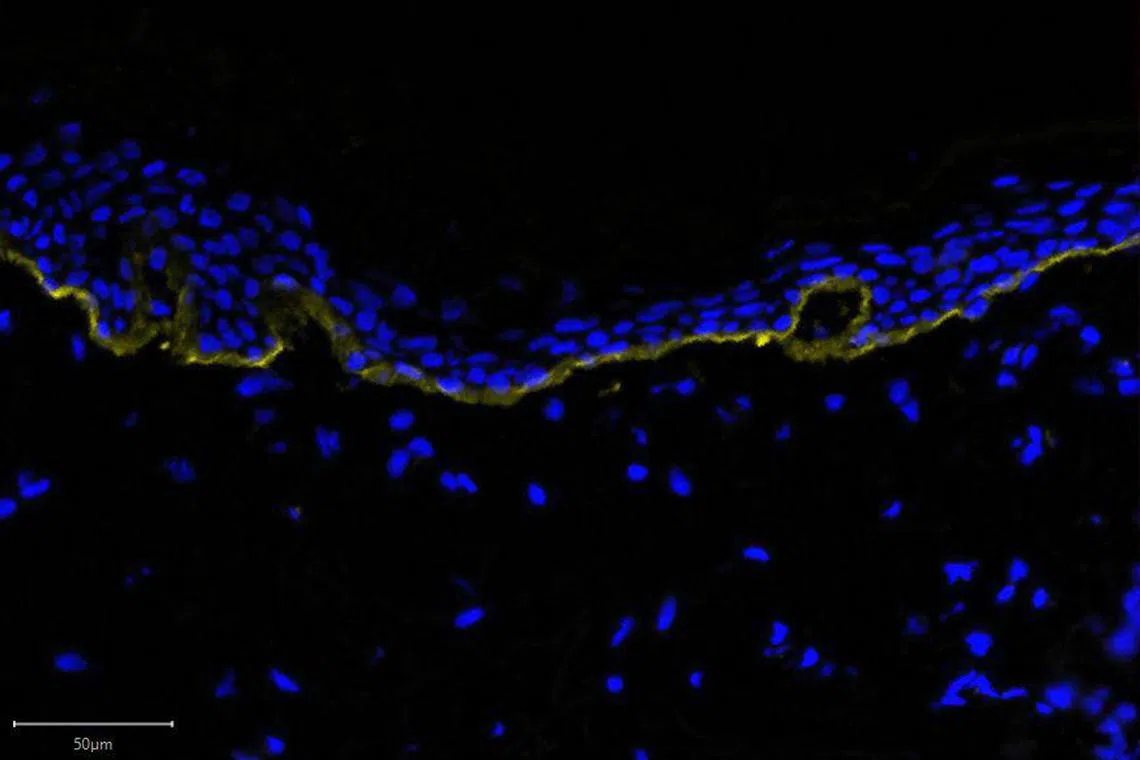Singapore embarks on $14 million study to understand how Asian skin ages
Sign up now: Get ST's newsletters delivered to your inbox

As we age, it becomes thinner, less elastic and more fragile.
PHOTO: ST FILE
Follow topic:
SINGAPORE – Not much is known about how Asian skin ages, because most dermatological research has focused on Caucasian populations.
This is set to change as Singapore embarks on a $14 million four-year multidisciplinary research initiative to look at what is driving skin ageing in Asians in order to address their age-related skin health issues, such as skin thinning and persistent itching.
As the largest organ in our body, the skin protects us against injuries and microbial attacks.
As we age, it becomes thinner, less elastic and more fragile. With the decline in its barrier function, there is a reduced ability to retain moisture, control temperature and protect the body from infectious agents and other harmful substances, among other functions.
The study – Cutaneous Ageing and Maintenance Programme – which is set to start on Aug 1, aims to discover innovative preventive measures and treatments that are tailored specifically for Asian skin, said its principal investigator, Professor Rachel Watson.
Prof Watson is an ageing skin expert and the executive director of the Agency for Science, Technology and Research (A*Star) Skin Research Labs and the Skin Research Institute of Singapore (SRIS).
The study will bring together clinicians, biologists, engineers and data scientists from SRIS’ tripartite partners: A*Star, the National Healthcare Group and Nanyang Technological University.
They will measure the physiology of Asian skin, study what is underpinning the changes, and create models that reflect skin in an aged environment.
“We’re trying to put all the groundwork in place, so that in four or five years we can start to look at interventions that will support how our skin behaves,” said Prof Watson.
Research published in 2022 by Dr Yew Yik Weng at the National Skin Centre (NSC) and other researchers here found that skin inflammation or dermatitis, viral skin diseases and fungal skin diseases are the top three most common skin conditions among the elderly here.
Said Prof Watson: “So in the younger population, you may see a lot of atopic dermatitis, commonly known as eczema, for example, but as you get older, other skin diseases start to become more prevalent, like seborrheic dermatitis, which mainly affects the scalp.
“We start to see more fungal infections of the skin, more cancers of the skin happening.”
The incidence of basal cell carcinoma, the most common form of skin cancer here, has increased in recent decades, said Professor Steven Thng, deputy director and senior consultant at NSC, citing a recent study of 12,692 cases diagnosed from 1968 to 2016.
Most cases of such cancers were diagnosed in those aged 60 and above, and the relative risk rises sharply with age, he said.

A microscopic image of skin from a 55-year-old Caucasian. Collagen type VII is visible as a yellow line between the outer and inner layers of skin.
PHOTO: SRIS
The study found that people aged 70 and above have 14.8 times the risk of getting basel cell carcinoma and 40.4 times the risk of the second-most common skin cancer in Singapore, known as squamous cell carcinoma, when compared with those under 40 years of age.
Furthermore, it found that fairer-skinned Chinese have the highest relative risk for developing any skin cancer compared with darker-skinned Malays and Indians.
Asian skin has more melanin, which better protects it from the sun’s ultraviolet rays but makes it more prone to pigmentation issues and scarring. The humid and sunny climate in many Asian regions also impacts skin differently from temperate climates.
“In Asian skin, we see changes to skin pigmentation and complexion much earlier than we see in Caucasian skin... We don’t see so much facial wrinkling in Asian skin,” said Prof Watson, who spent nearly 30 years in Britain studying Caucasian skin before coming to Singapore in 2023 to research Asian skin.
“We know that inflammation plays a role in (the ageing of Caucasian skin). Now, we want to test the hypothesis in Asian skin to see if the same process happens.”
There is evidence that some ingredients in skin care products can help protect skin, but they have been tested only in Western populations, said Prof Watson.
The best-studied molecule is a derivative of vitamin A called all-trans retinoic acid. When that is applied to the skin, it tells the cells to make more collagen and elastic fibres, so wrinkles may look as if they are disappearing, she said.
She likens the face to a balloon – what the vitamin A derivative does is to put air back into the balloon to inflate it. While it works, this active ingredient is typically found in facial products, and not body moisturisers, which would help with overall skin health.
To protect the skin, it is important to moisturise, exfoliate and use sunblock, particularly as one gets older and starts to lose pigmentation. Eating a variety of different-coloured fruits and vegetables, which are rich in dietary antioxidants, will help the skin fight against sun damage, said Prof Watson.
“But there is always going to be a decline in the tissue because of our age. So what we need to do is try and understand what else we can do to support the skin,” she said.
“It’s about moving away from the perception of beauty and cosmetics into things that can support all of our skin, and not just the skin on our face... It’s not just about how we look. It’s about how our skin behaves.”


